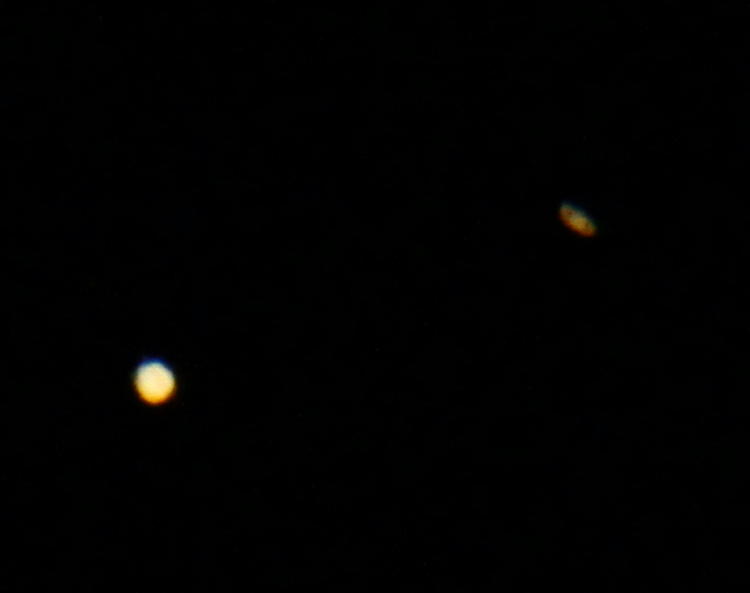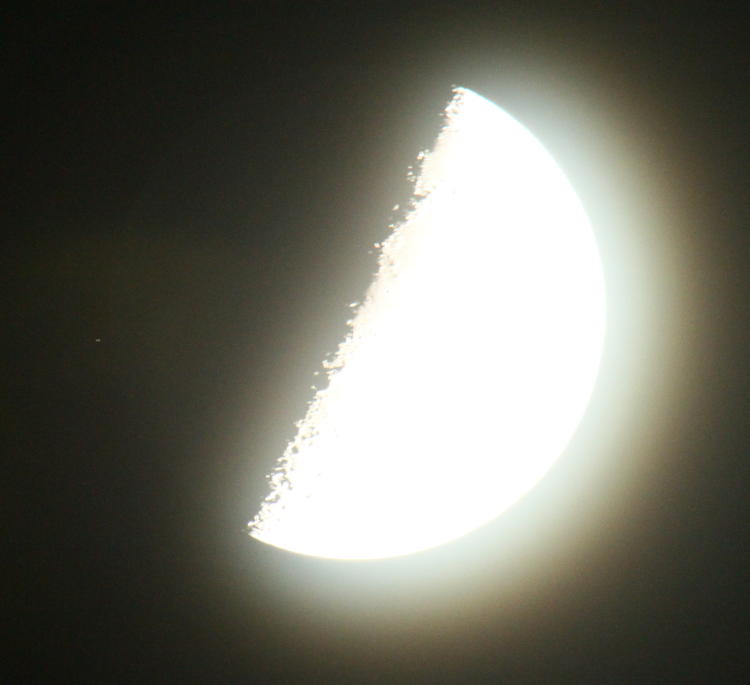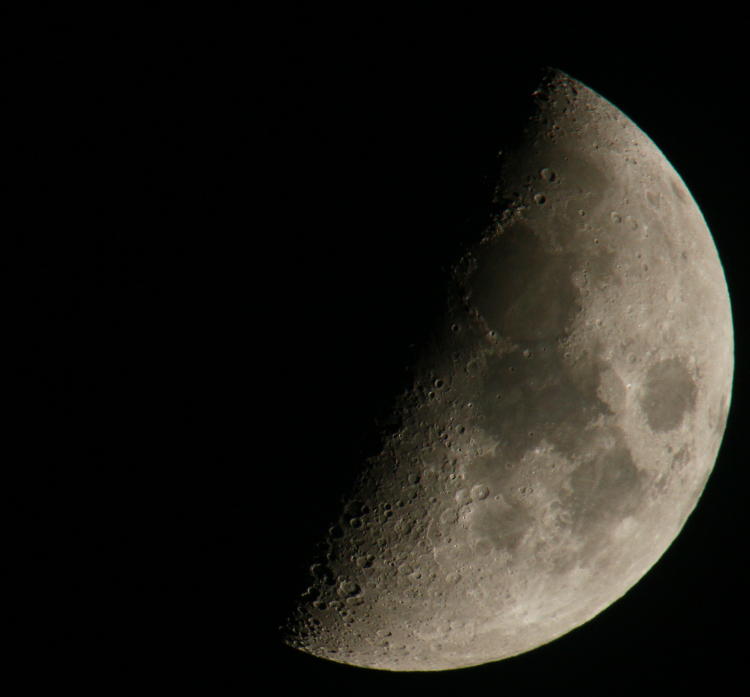Yes, I did indeed get out to view the conjunction of Jupiter and Saturn yesterday evening – for what it was worth. I can tell you right now, there are better efforts out there, with better, more dedicated equipment (and probably no small amount of digital “enhancement,” or “compositing,” or as most people call it, “photoshopping.”) I knew how challenging a really impressive photo (or video) would be, so I wasn’t holding my breath.
But enough hemmingenhawing – let’s see what I really got.

This was with the Tamron 150-600 at 600mm, with a (not quite) 2x teleconverter, so effectively about 1000mm, and this is full resolution – the sharpest that I got. Got the evidence of Saturn’s rings and the faintest hint of Jupiter’s banding, but none of its moons (even though four of them were very much in evidence.) They were too faint for this exposure, which was 1/25 sec, ISO 800, and attempts at brighter/longer exposures turned up just the barest hint – and a lot of motion blur.
This was not from the rotation of the Earth, but instead from the breeze. We – meaning The Girlfriend, Buggato, and myself – had all gone down to a prime spot on Jordan Lake with a decent view to the west-southwest – and so had quite a few other people, several dozen at least. It was actually hard to tell, since there are no lights there and thus a decent count wasn’t going to happen – actually recognizing anyone else wasn’t going to happen. There was everything from people attempting to take photos with a handheld phone (snerk!) to some damn big telescopes on hand, and everything in between. I actually had two moderate telescopes along, but both of them have been in the process of getting put into spec and so neither one was going to get anything better than what I got with the camera lens, and actually much worse.
Here’s the deal: a standard telescope eyepiece is optimized for the ‘exit pupil’ which is just a little larger than your eye’s own pupil, because that’s all it needs, and this makes it several dozen times smaller than a camera sensor. Not to mention that it has its own lenses optimized for the focal length and light path. So attaching a standard SLR camera isn’t going to produce what we see when peering through the scope, because of this exit pupil thing, the lack of intervening lenses, and the size of the camera body itself (mostly the mirror box for that reflex mirror to throw the image to the camera viewfinder.) Ideally, a dedicated eyepiece camera should be used, but they’re damned expensive and I’m not into it enough to drop that kind of dough, especially when good exposures of interesting stuff will also need to have a tracking motor (which I have now, though I haven’t tried it yet) and precise alignment every time the scope is set up so the motor is actually going in the direction it should. That becomes a lot of effort for an area that possesses far too much light pollution. Plus the rig is large and cumbersome. So I should simply not have bothered with it at all last night, but briefly, I had a peek at the conjunction in the eyepiece, and it was pretty cool – moons plainly visible, and much brighter planets that the photo above. There’s still a chance that further efforts will appear here later on – just, not of such a conjunction because that’s a wee bit down the road.
While there, I re-aimed at the first-quarter moon and did a little video, which if nothing else demonstrated the effect of the breeze on the rig. I could have combated this a little by keeping the tripod down as far as possible, reducing the length of the leg and center columns that would be susceptible to the wind, and that would have worked better for the conjunction, down near the horizon as it was – not so much for the moon, way above at a 50° altitude. But anyway, here’s the clip, and note that even though the crowd is easily audible, the breeze barely makes an impression on the very wind-sensitive onboard mic – this was a breeze, and nothing more.
Now a trivial find, as I was editing. I was using the moon for sharp manual focusing, because the planets were far too small and with too little detail for precise work, and fired off a frame while the exposure was still set for the planets (and Jovian moon attempts.) Of course this overexposed the moon a hair, but it also brought out something else.

At full resolution, there’s a hint of motion blur at the terminator on the moon, and of course the exposure glare – but there’s a little boogie over on the dark side of the moon. No, it’s not a little prism (you’ll get it eventually,) but I wasn’t sure what it was, and to my eye, it was borderline of being inside the arc of the moon’s darkened edge – which would make it a satellite in front of the moon. I quickly brought up Stellarium (instead of sitting upright in my chair) and determined that it was only a star – but one that, had I kept watching for only a few minutes longer, would have disappeared behind the moon. Well, hell anyway – not that I could have done much about it, since a) it wasn’t visible even slightly to the naked eye, and so I didn’t know it was there, and b) it would not have been visible in video exposures either, so the actual disappearance could not be captured. Which is a shame, because winking out on the dark side would look cooler than disappearing against the bright side.
[A note: While the motion of the Earth’s rotation has the moon sliding left to right across the sky, at least in this hemisphere, the star disappeared against the left side, meaning the moon was moving left – which is true, since it pursues its own orbit. In essence, it moves a little bit slower across the sky than the background stars – and during a lunar eclipse, this motion also becomes apparent.]
Oh, and the reason that I said, “instead of sitting upright in my chair” above is that, despite the money I spent on this computer monitor, it still has a bit of gamma difference depending on viewing angle, and it takes a direct, or slightly high, angle to make out the full range of light. Had I been sitting up, I could have seen the very faint hint of Earthshine on the dark side of the moon, and known the star was indeed outside that arc. If you can’t make it out yourself, you may want to adjust your own monitor – it’s barely visible, but there – and if you’re doing this on a phone, I only laugh at you because you shouldn’t be playing with toys at your age.
But while we’re here, I’ll include a ‘normal’ exposure of the moon, only moments after the one above – as you can see, that rogue star isn’t visible, though it would be a few more minutes before it actually vanished behind the moon.

I’m slowly getting back into posting, though in your favor, I’ve been avoiding venting about the numerous frustrations that have been occurring, but regardless, I’ll get some more out a bit at a time. Go drink some eggnog or something in the meantime.




















































